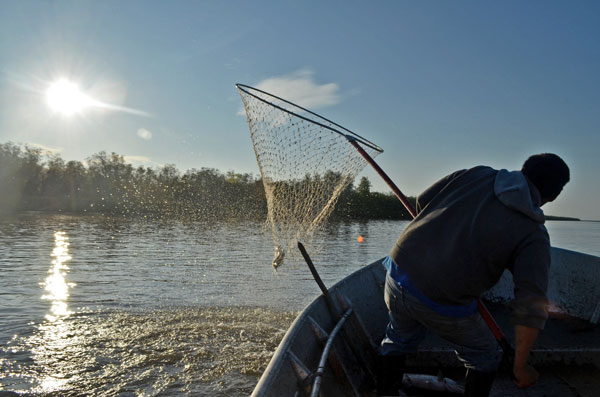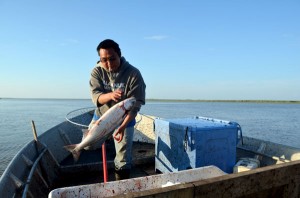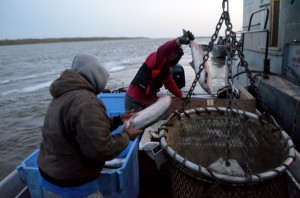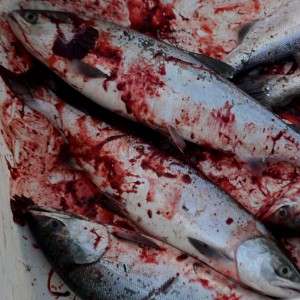
An unprecedented set of new policies from Alaska’s Department of Fish and Game are changing the way Yukon commercial and subsistence fisherman have been fishing their entire lives. Some residents are using Kenai River style dip nets for the first time and catching lots of fish.
Besides fisherman on the lower Yukon, this may be the first time anyone has heard a Yup’ik fisherman releasing a King Salmon back into the river.

That’s James Isidore and his cousin Felix Patrick, two commercial fishermen from Alakanuk, a village about 10 miles downriver of Kwik’pak fisheries in Emmonak.
By now, Isidore and Patrick are used to fishing restrictions, especially when it comes to King salmon. A 1998 King population decline saw the 300,000 average King salmon run size plummet to half that. And this year, run projections, even towards the high end, are less than 150,000. There’s a host of possible reasons for the dwindling King population but no one knows for sure.
“Well, they’re trying to save the King so I’m for that,” Isadore says. “So my kids and their kids can eat Kings some day, freely.”
But even so, Isidore says, the idea of not keeping even the few they’re used to catching is unsettling.
“There it goes,” Isadore says as he drops another King into the Yukon. “Gone.”
Yup’ik fishermen have been relying on King Salmon to feed their families for hundreds of years. Kings are larger, have an increased fat content and provide more nutrients than other species of salmon. Patrick says one good-sized King can feed his family for a week.
Besides throwing back Kings, they’re also the first Yup’iks who are forced to use dip nets; a style of fishing that departs from the traditional gill net drift fishing they’re used to.
With run sizes of more than a million, the target fish on the Yukon is Chum Salmon. Biologist and private consultant for Kwik’pak fisheries Gene Sandone was part of a research team that tested alternative fishing methods seeking to balance sustainability with industry.

“We tested different areas to see if we could actually catch Chum salmon in commercial quantities,” Sandone says.
At the same time they wanted to find a way to catch Kings without killing them, as gill nets tend to do. They tested two sections of the Lower Yukon using two to four Kenai type dip nets in each boat.
“And we did catch a number of Chum salmon but nothing outstanding,” Sandone says. “I think the highest rate of catch we got was 40 per hour per dip net.”
They also tested beach seine gear, although it’s not being used now due to high water.
In January the Alaska Board of Fish approved the new gear.
Many Yukon fishermen initially resisted the method. During the first period on June 18 only 12 commercial boats were on the water, Isadore’s being one of them.
Because the gear is new there’s no right way to use it. Some fishermen anchor to the shore and others drift perpendicular to the current. Isidore points his boat downriver and propels along a line he’s plotted on his depth finder. They need to be shallow to catch and at first it’s slow going.
But, once he get’s on track they pull in one, two and sometimes three fish after each dip.
This results in one of the big complaints about dip nets. It takes a lot of strength to hold the net in the current and pull it out hundreds of times a day. But Isidore and Patrick adapted quickly.

“About 20 minutes after we started,” Isadore says.
They tied small limbs to the side of the boat and use them for leverage against the current and when they catch and pull. It’s hard on the equipment. The force warps the poles and they have to turn the pole around every time bows too much.
“But it was harder on us than the equipment so it’s better the equipment than us,” Isadore says. “It takes off a lot of pressure.”
Even though some people are still hesitant about the new restrictions, 140 boats are now on the river.
“I don’t see why people are complaining,” Isadore says. “we got 800 pounds of fish in four hours with dip nets. That’s not too bad.”
Isidore drove his boat 35 miles upriver from Emmonak near a place called 10-mile island. They drift about a mile downriver before turning around and doing it all over again. The fishing period ends at 12 a.m. and they don’t stop dipping their nets a second early.
“12 o’clock,” Isadore says.
“Yep one more see, one more,” Isadore says. “Every second counts.”
They brought back more than one thousand pounds of Chum Salmon to the fishery. Chum is selling at 75 cents a pound, a good price now, but like restrictions across the entire YK Delta it’s bound to change. Another fact Isidore and Patrick are used to.
“There’s always different kinds of hunting rules, fishing rules,” Isadore says. “You can be mad about it. It’s not going to make any difference.”
Until further notice, the gear restrictions and catch and release policy are in effect through Saturday June 29th.




